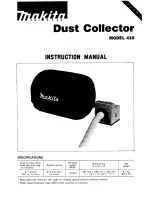
ELECTRICAL INSTALLATION, WIRING AND TROUBLESHOOTING
Nederman Customer Service & Technical Support [email protected]
+1 (336) 821-0800
9
Trip Class
10A 2 < Ti ≥ 10
10
4 < Ti ≥ 10
20
6 < Ti ≥ 20
30
0.5 < Ti ≥ 30
Section 5.0 – Inrush
When an AC induction motor starts, the supply voltage creates a magnetic field in the stator that induces a
magnetic field in the rotor. The interaction of these two magnetic fields produces torque turning the motor.
The creation of the magnetic field causes an induced voltage that opposes the supply voltage known as “back
EMF” that also limits the amount of current in the motor.
The amount of “back EMF” produced is directly proportional to the speed of the motor so at startup, when the
motor speed is near zero, there is very little “back EMF” and high “inrush” current is allowed to flow. The highest
level of inrush current occurs during the first half
‐
cycle of motor operation and can be more than 10 times the
motor’s FLA (full
‐
load amperage). As the motor turns, the current decreases to the level of the motor’s locked
rotor current, which is often six to eight times the motor’s normal operating current. As the motor speed and
“back EMF” increases, the current further decreases, until normal operating speed and current are reached.
High inrush current can:
•
Cause nuisance tripping of protective devices or motor damage.
•
Cause voltage dips in the supply line (which can affect other equipment).
•
Prevent the motor from properly starting.
•
Cause high torque production, exceeding motor ratings, causing sudden and severe acceleration
damaging mechanical loads.
Tip for Inrush:
Use the overload adjustable trip class function that increases the time that the overload experiences the
locked rotor current and motor reaches steady state. This will be evident as the motor will try to start and trip
the overload. Below is an example of an adjustable trip class.























